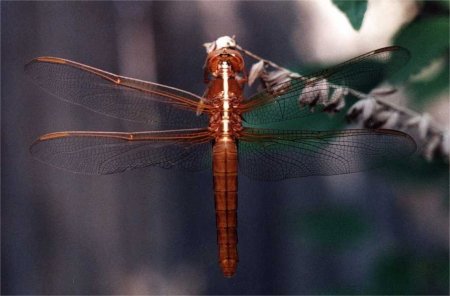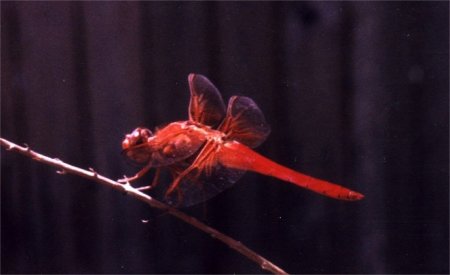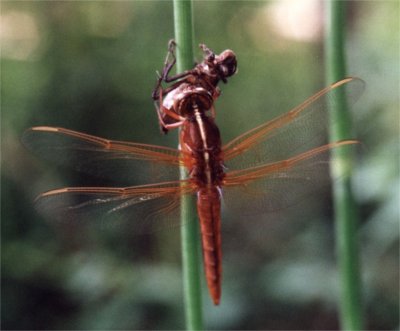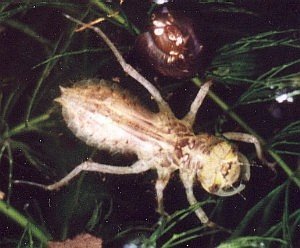Dragonflies
by Valerie (October 15, 2000)
revised July 28, 2002
 
Dragonfly larvae are squat, brown creatures that propel themselves through the water by forcing a current out their rear end. They can move about pretty well this way, but they also walk around, stalking prey on the bottom of the pond, or in the plants, and their drab color is effective camouflage. The larvae seem to eat just about everything they can catch, including the other insects and snails.
Although we have a couple different kinds of dragonflies, one type predominates. This species has bright red males and golden females. The males are exceedingly territorial, having favorite perches on bare branches or sticks where they can watch over the pond areas. When another male comes around, they chase each other around, sometimes circling the house in a very short period of time. I've also watched a brilliant red male dragonfly chase away a hummingbird, also known as one of the most territorial of creatures (and they weren't even competing for the same resources)!
The males are, of course, waiting around their prime real estate for females to be attracted. When laying eggs, the female repeatedly flies down to the water and dips her abdomen in. She does this with such force that a drop of water is thrown about a foot. This action is repeated many times in quick sequence (about once every second or two), as the female makes a circle around the open water area. I assume she is laying only one egg at a time, since I lost count after about 50 passes. It would make sense to spread her eggs out, since the baby dragonflies would probably eat each other if there was nothing else convenient.
While most of the dragonfly larvae are so dark that they are barely visible against the background vegetation, roots and dark pond liner, I found one that was almost white, pictured below at right. It seemed healthy in every respect, calmly walking around on the pond plants just like its dark colored siblings. The color was so striking, though, that I couldn't help but notice this individual and, while it would be a great disadvantage in the wild, where fish and other predators might quickly dispose of it, in our pond, there are none of the usual dangers.
Because the dragonfly larvae take a long time to mature, some of them probably spend the winter in the ponds. It is very difficult to clean the ponds out, because of all the snails and insect larvae that get scooped up in the net with the leaves and dirt. I usually give the ponds a good cleaning very early in the spring, before the toads and insects have a chance to start laying eggs again. However, this past spring, as I was scooping the muck from the bottom of one pond, I eventually noticed, perched on a horsetail right next to me, a dragonfly that had just emerged from its larval shell. |

 While bluejays and grackles sometimes pose a threat, they are quite limited when it comes to preying on aquatic denizens. An interesting feature of this larva was its almost transparent outer skin, which allowed a view of its internal organs so that I could actually see its abdomen pulse as it was breathing.
While bluejays and grackles sometimes pose a threat, they are quite limited when it comes to preying on aquatic denizens. An interesting feature of this larva was its almost transparent outer skin, which allowed a view of its internal organs so that I could actually see its abdomen pulse as it was breathing.